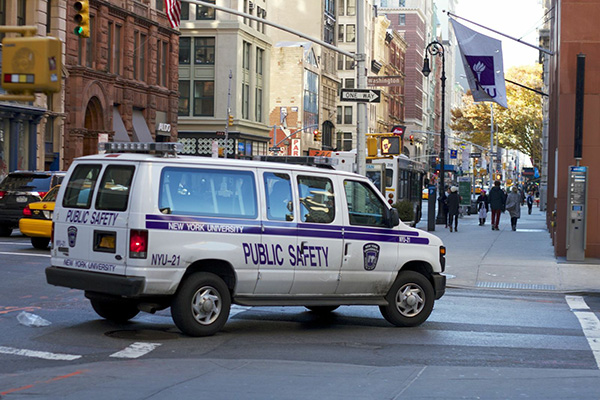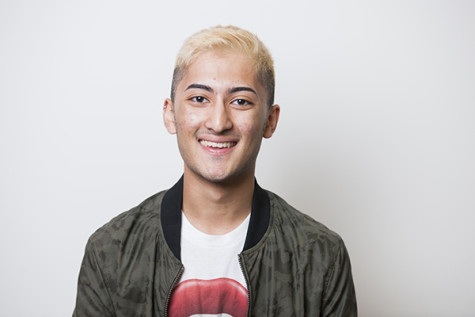Public Safety reassesses safety measures in wake of assault incidents
November 14, 2013

In response to NYU’s two incidents of assault occurred around campus in October, university officials are in the process of reviewing the University’s Public Safety Standards.
“Since the Catholic Center assault, Public Safety has increased its presence on campus with additional patrols in the early morning hours that use marked vehicles with roof-top bar lights turned on so they are more visible to the community,” NYU spokesman Philip Lentz said.
On Oct. 31, a 24-year-old female NYU employee employed at the Global Center for Academic and Spiritual Life was forced inside the Catholic Center and raped on Oct. 31.
Another high profile incident earlier in the month occurred on Oct. 8, when 20-year-old student was a victim of assault and robbery near SoHo. She was able to get away from the assailant, but she lost many of her personal belongings.
Lentz said this increased security will last at least as long as the investigation into the rape incident lasts.
Stern Freshman Luisa Coutinho has a class in the Catholic Center and said the increased presence was positive.
“Even after the suspect is apprehended, such measures should be continued in order to prevent future crimes of a similar nature,” Coutinho said. “The issue of safety is concerning for me after such an incident. Hopefully, safety measures will be not only increased, but continued.”
Margaret Smiley, CAS senior and the president of the Feminist Society at NYU said the increased presence was a good step for student safety.
“In regards to the attacks and attempted rapes on campus, I think the university did a good job of exposing the case and [the] situation [to] students,” Smiley said.
NYU provides a 24/7 emergency response hotline, with Crisis Response Counselors, in addition to walk-in counseling.
The Feminist Society and the NYU Wellness Exchange co-created a new website regarding sexual assault and prevention that launched in the fall of 2013, before either of the incidents.
“The NYU Wellness Exchange provides students with immediate comprehensive support,” Lentz said. “We do in fact offer all the services typically provided by rape crisis centers and more.”
In addition, one of NYU’s main resources for students traveling at later hours is the late-night shuttle service SafeRide.
Lentz said the service SafeRide recorded 2,304 passengers in September, 3,309 in October and 1,692 in November thus far. Around 55 percent coming from residence halls, around 32 percent coming from Bobst Library and about 13 percent coming from other NYU buildings and facilities. The primary destinations are residence halls. According to the NYU website, about 11,000 undergraduate and graduate students live in on-campus housing.
Steinhardt freshman Sonja Haroldson said though SafeRide is inconsistent in its timeliness, she is happy it is part of NYU’s services and she takes SafeRide because she is uncomfortable walking home late at night.
“I use [SafeRide] up to two to three times a week,” Haroldson said. “Also, being a college student, I would much rather wait an extra half hour than pay seven dollars for a cab.”
Morgan Bennyworth, Gallatin junior, acknowledges the safety resources that NYU offers but questions how effective they are once someone steps out of NYU’s buildings. She said that though the security cameras in buildings are reassuring, she has doubts about their monitoring and effectiveness.
“I believe that NYU has sufficient safety resources, but feel that sometimes that isn’t enough, especially when you’re ‘on campus,’ but not in an NYU building,” Bennyworth said. “I assume it would cost a lot to up security at odd hours and in places on campus that don’t get a lot of foot traffic, but something should be fixed after this latest incident.”
Lentz said NYU and the New York Police Department have a strong relationship, in which the NYPD patrol Washington Square Park and surrounding neighborhoods.
In addition to 23 emergency phones around campus, local businesses have agreed to be safe havens where students can seek safety.
“Every student residence hall is staffed 24/7 by Public Safety officers and most University buildings are staffed by Public Safety officers,” Lentz said.
Some NYU buildings, like Bobst and Kimmel, have turnstile entrances that require students to swipe or tap their IDs but others, like the Silver Center, simply require students show their ID as they walk in. Lentz said that this discrepancy exists because of many factors, such as how lobbies are configured and compliance with the city’s fire and building codes.
A review of Public Safety is ongoing but the results will not be publicized. The internal review aims to improve public safety’s operations in maintaining campus safety and preventing crime. Lentz said reviews occur after any major incident.
A version of this article appeared in the Thursday, Nov. 14 print edition. Kavish Harjai is a staff writer. Email him at [email protected].
























































































































































